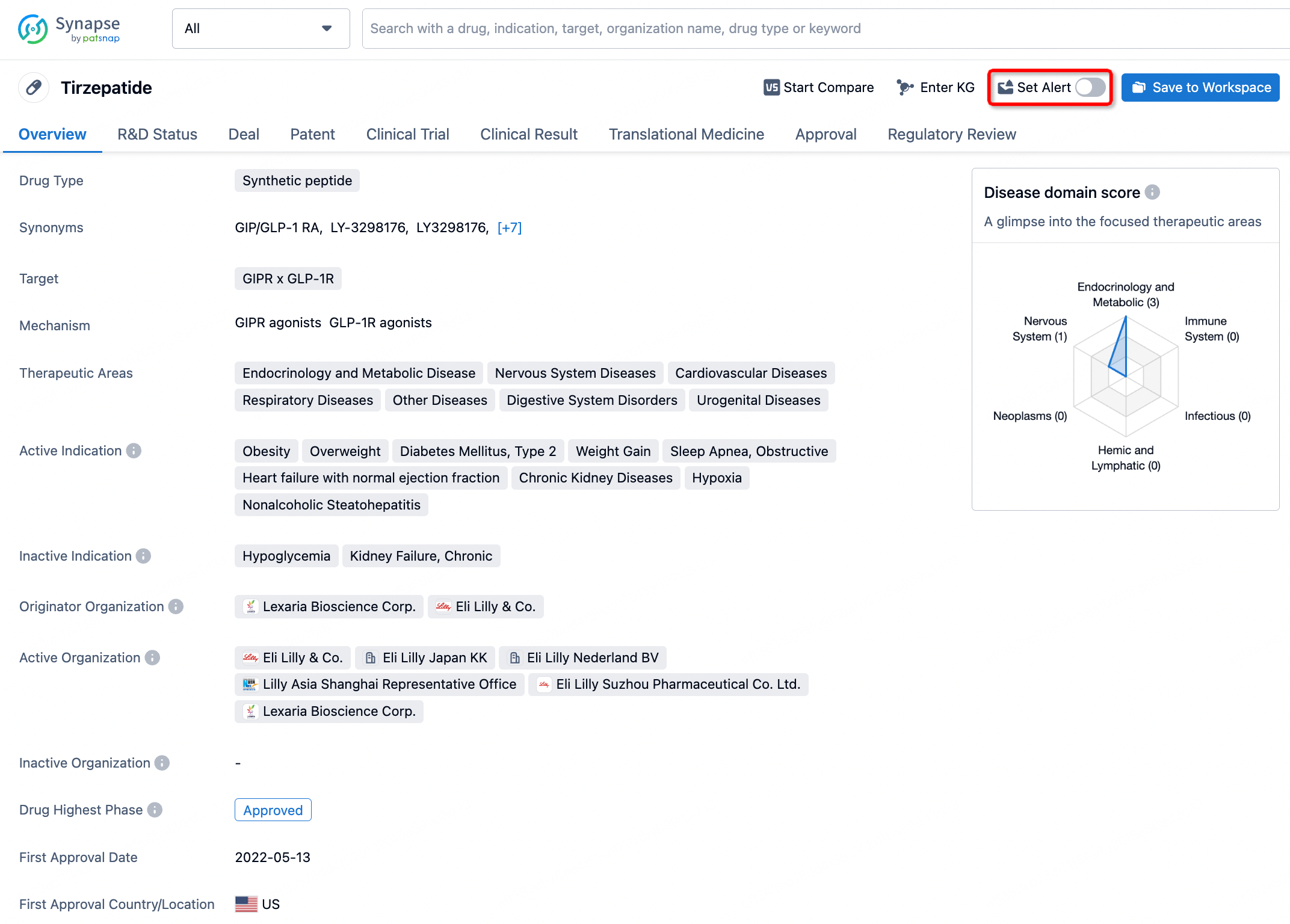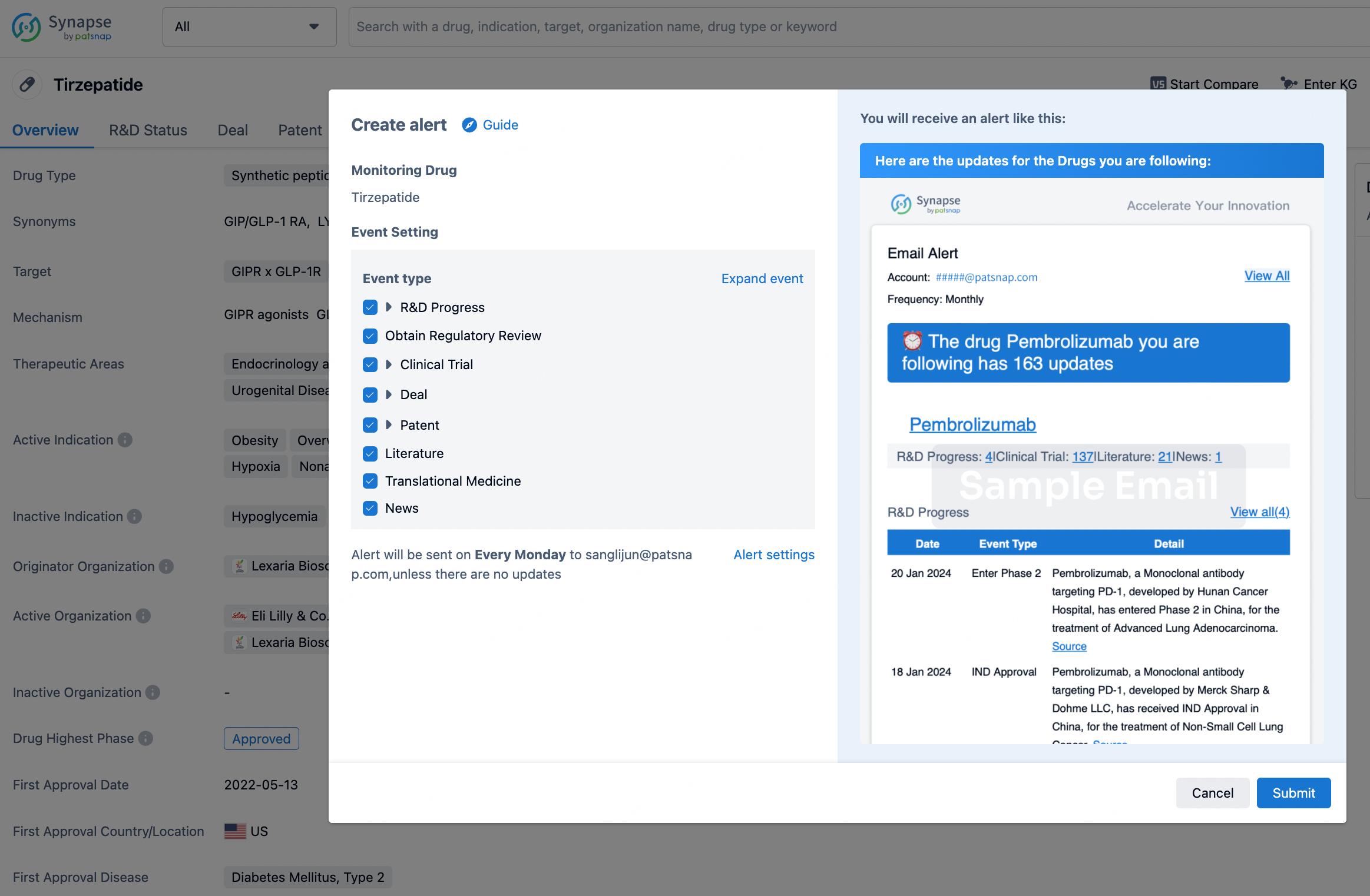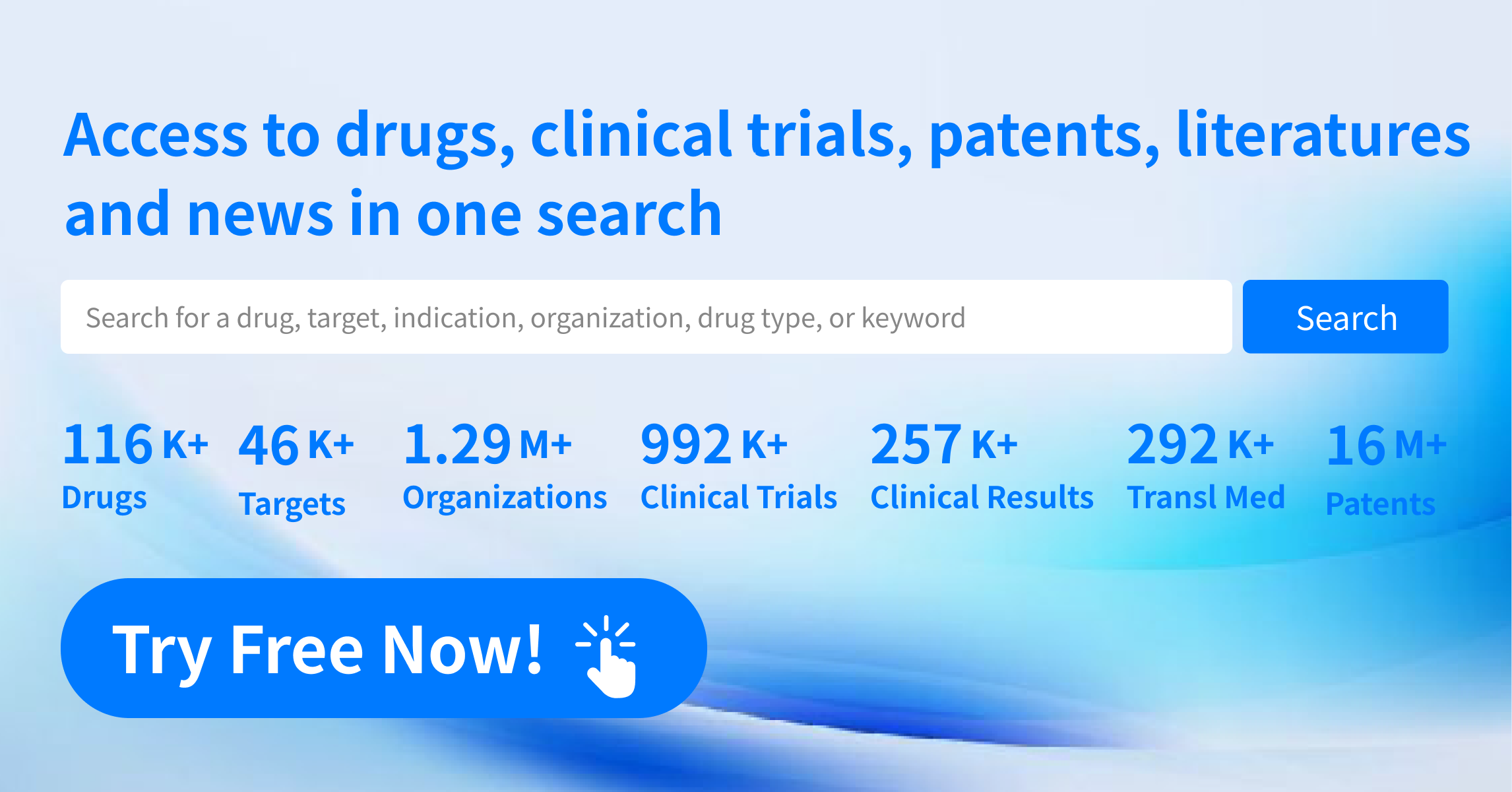Request Demo
What is Dihydroxydibutylether used for?
15 June 2024
Dihydroxydibutylether (DHDBE) is a relatively new and emerging compound in the pharmaceutical landscape. It has generated significant interest due to its unique chemical structure and potential therapeutic applications. Currently, DHDBE does not have any widely recognized drug trade names, as it is still predominantly in the research and development phase. Various research institutions and pharmaceutical companies are exploring its potential, particularly in the fields of neurology and oncology.
This compound is primarily being investigated as a novel therapeutic agent. Its specific targets include the modulation of neurotransmitter activity in the brain and the inhibition of certain cancer cell metabolic pathways. Researchers are particularly interested in DHDBE's ability to cross the blood-brain barrier, making it a promising candidate for treating neurodegenerative diseases such as Alzheimer's and Parkinson's.
In terms of indications, DHDBE has shown potential in preclinical studies for its neuroprotective and anticancer properties. However, it is important to note that the research is still in its early stages, and no definitive clinical applications have been established yet. The progress of research on DHDBE is ongoing, with numerous studies currently being conducted to better understand its efficacy and safety profile.
Dihydroxydibutylether Mechanism of Action
The mechanism of action of Dihydroxydibutylether is multifaceted and involves several biochemical pathways. One of the primary mechanisms through which DHDBE exerts its effects is by modulating neurotransmitter activity in the central nervous system. It has been found to interact with GABAergic and glutamatergic receptors, leading to a balanced neurotransmission. This modulation helps in reducing neuroinflammation and oxidative stress, which are common contributors to neurodegenerative diseases.
In the context of oncology, DHDBE has demonstrated the ability to inhibit key metabolic pathways that are crucial for the survival and proliferation of cancer cells. By disrupting the energy production processes within these cells, DHDBE induces apoptosis, or programmed cell death, thereby reducing tumor growth. Additionally, it appears to have a role in enhancing the efficacy of existing chemotherapeutic agents, making it a potential candidate for combination therapy.
Moreover, DHDBE's antioxidant properties further contribute to its therapeutic potential. By scavenging free radicals and reducing oxidative stress, it helps in protecting cells from damage, thereby extending its benefits beyond just neuroprotection and anticancer activities.
How to Use Dihydroxydibutylether
Currently, the methods of administration for Dihydroxydibutylether are still being refined as part of ongoing research. However, based on preclinical studies, several potential routes of administration have been identified. These include oral, intravenous, and intranasal delivery methods. Each method has its own set of advantages and challenges.
Oral administration is the most convenient and non-invasive method, but it requires careful formulation to ensure that DHDBE is adequately absorbed in the gastrointestinal tract. Intravenous administration provides the most direct and controlled delivery, ensuring that the compound quickly reaches systemic circulation. Intranasal delivery is particularly promising for targeting the central nervous system, as it allows the compound to bypass the blood-brain barrier more efficiently.
The onset time of DHDBE's effects can vary depending on the route of administration. Intravenous administration typically results in the fastest onset, often within minutes. Oral administration may take longer, ranging from 30 minutes to an hour, as the compound needs to be metabolized and absorbed. Intranasal delivery offers an intermediate onset time, usually within 15 to 30 minutes, due to its direct access to the brain.
It is important to note that DHDBE is still in the experimental phase, and no standardized dosing guidelines have been established. As research progresses, more information will become available regarding the optimal methods of administration and dosing regimens.
What is Dihydroxydibutylether Side Effects
Like all pharmaceutical agents, Dihydroxydibutylether is not without its potential side effects. While preclinical studies have shown promising results, some adverse effects have also been observed. The most commonly reported side effects include gastrointestinal disturbances such as nausea, vomiting, and diarrhea. These effects are generally mild and tend to resolve on their own.
In some cases, DHDBE has been associated with central nervous system side effects such as dizziness, headache, and mild sedation. These effects are thought to be related to its interaction with neurotransmitter receptors and typically subside with continued use or dose adjustment.
More serious side effects, although rare, have been reported in animal studies. These include hepatic toxicity and renal impairment, indicating that long-term use of DHDBE may require monitoring of liver and kidney function. It is crucial for ongoing research to further investigate these potential risks and establish safety guidelines.
Contraindications for DHDBE use have not been fully defined due to the limited data available. However, it is generally recommended that individuals with a history of hypersensitivity to similar compounds or those with significant liver or kidney disease exercise caution. Pregnant and breastfeeding women should avoid DHDBE use until more information is available regarding its safety in these populations.
What Other Drugs Will Affect Dihydroxydibutylether
The interaction of Dihydroxydibutylether with other drugs is an area of active investigation. Given its multifaceted mechanism of action, DHDBE has the potential to interact with a variety of pharmaceutical agents. One of the primary concerns is its interaction with other central nervous system depressants, such as benzodiazepines and barbiturates. Concurrent use of these drugs may potentiate sedative effects and increase the risk of central nervous system depression.
DHDBE's impact on hepatic enzymes also suggests potential interactions with drugs that are metabolized by the liver. Enzyme induction or inhibition could alter the pharmacokinetics of co-administered drugs, leading to either reduced efficacy or increased toxicity. It is advisable for researchers and clinicians to monitor for drug-drug interactions and adjust dosing regimens accordingly.
The antioxidant properties of DHDBE may also influence the activity of other compounds with similar effects. For example, combining DHDBE with other antioxidant agents could lead to an additive effect, which might be beneficial in some cases but could also increase the risk of adverse effects in others.
In conclusion, while Dihydroxydibutylether holds significant promise as a therapeutic agent, much remains to be learned about its safety, efficacy, and interaction profile. Ongoing research will be crucial in fully elucidating these aspects and paving the way for its potential clinical applications.
This compound is primarily being investigated as a novel therapeutic agent. Its specific targets include the modulation of neurotransmitter activity in the brain and the inhibition of certain cancer cell metabolic pathways. Researchers are particularly interested in DHDBE's ability to cross the blood-brain barrier, making it a promising candidate for treating neurodegenerative diseases such as Alzheimer's and Parkinson's.
In terms of indications, DHDBE has shown potential in preclinical studies for its neuroprotective and anticancer properties. However, it is important to note that the research is still in its early stages, and no definitive clinical applications have been established yet. The progress of research on DHDBE is ongoing, with numerous studies currently being conducted to better understand its efficacy and safety profile.
Dihydroxydibutylether Mechanism of Action
The mechanism of action of Dihydroxydibutylether is multifaceted and involves several biochemical pathways. One of the primary mechanisms through which DHDBE exerts its effects is by modulating neurotransmitter activity in the central nervous system. It has been found to interact with GABAergic and glutamatergic receptors, leading to a balanced neurotransmission. This modulation helps in reducing neuroinflammation and oxidative stress, which are common contributors to neurodegenerative diseases.
In the context of oncology, DHDBE has demonstrated the ability to inhibit key metabolic pathways that are crucial for the survival and proliferation of cancer cells. By disrupting the energy production processes within these cells, DHDBE induces apoptosis, or programmed cell death, thereby reducing tumor growth. Additionally, it appears to have a role in enhancing the efficacy of existing chemotherapeutic agents, making it a potential candidate for combination therapy.
Moreover, DHDBE's antioxidant properties further contribute to its therapeutic potential. By scavenging free radicals and reducing oxidative stress, it helps in protecting cells from damage, thereby extending its benefits beyond just neuroprotection and anticancer activities.
How to Use Dihydroxydibutylether
Currently, the methods of administration for Dihydroxydibutylether are still being refined as part of ongoing research. However, based on preclinical studies, several potential routes of administration have been identified. These include oral, intravenous, and intranasal delivery methods. Each method has its own set of advantages and challenges.
Oral administration is the most convenient and non-invasive method, but it requires careful formulation to ensure that DHDBE is adequately absorbed in the gastrointestinal tract. Intravenous administration provides the most direct and controlled delivery, ensuring that the compound quickly reaches systemic circulation. Intranasal delivery is particularly promising for targeting the central nervous system, as it allows the compound to bypass the blood-brain barrier more efficiently.
The onset time of DHDBE's effects can vary depending on the route of administration. Intravenous administration typically results in the fastest onset, often within minutes. Oral administration may take longer, ranging from 30 minutes to an hour, as the compound needs to be metabolized and absorbed. Intranasal delivery offers an intermediate onset time, usually within 15 to 30 minutes, due to its direct access to the brain.
It is important to note that DHDBE is still in the experimental phase, and no standardized dosing guidelines have been established. As research progresses, more information will become available regarding the optimal methods of administration and dosing regimens.
What is Dihydroxydibutylether Side Effects
Like all pharmaceutical agents, Dihydroxydibutylether is not without its potential side effects. While preclinical studies have shown promising results, some adverse effects have also been observed. The most commonly reported side effects include gastrointestinal disturbances such as nausea, vomiting, and diarrhea. These effects are generally mild and tend to resolve on their own.
In some cases, DHDBE has been associated with central nervous system side effects such as dizziness, headache, and mild sedation. These effects are thought to be related to its interaction with neurotransmitter receptors and typically subside with continued use or dose adjustment.
More serious side effects, although rare, have been reported in animal studies. These include hepatic toxicity and renal impairment, indicating that long-term use of DHDBE may require monitoring of liver and kidney function. It is crucial for ongoing research to further investigate these potential risks and establish safety guidelines.
Contraindications for DHDBE use have not been fully defined due to the limited data available. However, it is generally recommended that individuals with a history of hypersensitivity to similar compounds or those with significant liver or kidney disease exercise caution. Pregnant and breastfeeding women should avoid DHDBE use until more information is available regarding its safety in these populations.
What Other Drugs Will Affect Dihydroxydibutylether
The interaction of Dihydroxydibutylether with other drugs is an area of active investigation. Given its multifaceted mechanism of action, DHDBE has the potential to interact with a variety of pharmaceutical agents. One of the primary concerns is its interaction with other central nervous system depressants, such as benzodiazepines and barbiturates. Concurrent use of these drugs may potentiate sedative effects and increase the risk of central nervous system depression.
DHDBE's impact on hepatic enzymes also suggests potential interactions with drugs that are metabolized by the liver. Enzyme induction or inhibition could alter the pharmacokinetics of co-administered drugs, leading to either reduced efficacy or increased toxicity. It is advisable for researchers and clinicians to monitor for drug-drug interactions and adjust dosing regimens accordingly.
The antioxidant properties of DHDBE may also influence the activity of other compounds with similar effects. For example, combining DHDBE with other antioxidant agents could lead to an additive effect, which might be beneficial in some cases but could also increase the risk of adverse effects in others.
In conclusion, while Dihydroxydibutylether holds significant promise as a therapeutic agent, much remains to be learned about its safety, efficacy, and interaction profile. Ongoing research will be crucial in fully elucidating these aspects and paving the way for its potential clinical applications.
How to obtain the latest development progress of all drugs?
In the Synapse database, you can stay updated on the latest research and development advances of all drugs. This service is accessible anytime and anywhere, with updates available daily or weekly. Use the "Set Alert" function to stay informed. Click on the image below to embark on a brand new journey of drug discovery!
AI Agents Built for Biopharma Breakthroughs
Accelerate discovery. Empower decisions. Transform outcomes.
Get started for free today!
Accelerate Strategic R&D decision making with Synapse, PatSnap’s AI-powered Connected Innovation Intelligence Platform Built for Life Sciences Professionals.
Start your data trial now!
Synapse data is also accessible to external entities via APIs or data packages. Empower better decisions with the latest in pharmaceutical intelligence.


